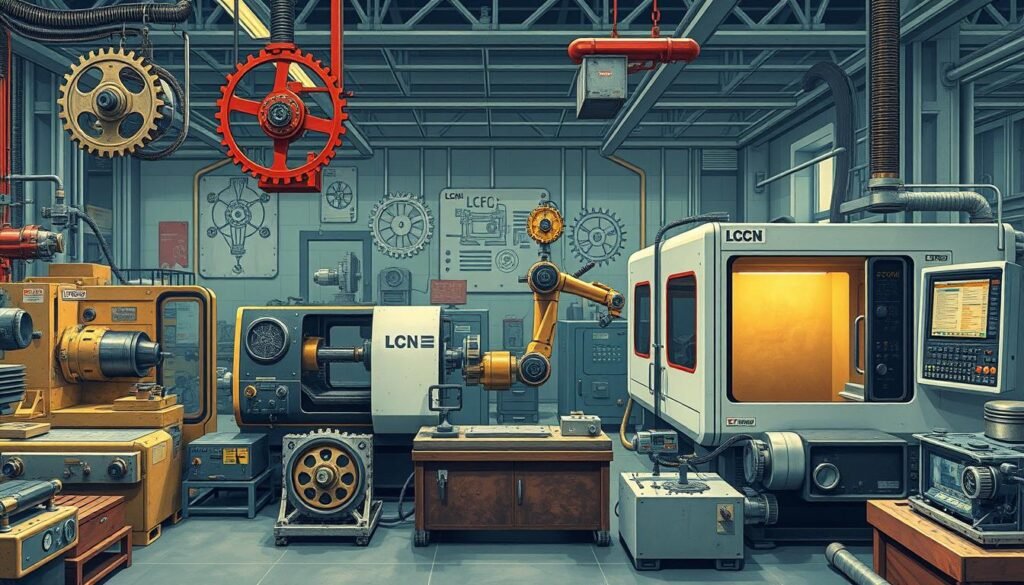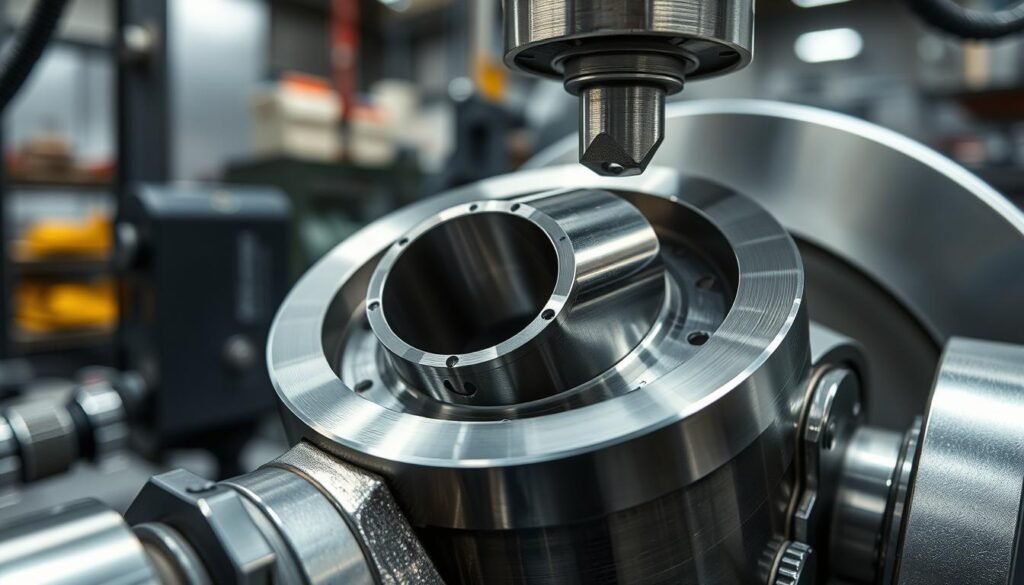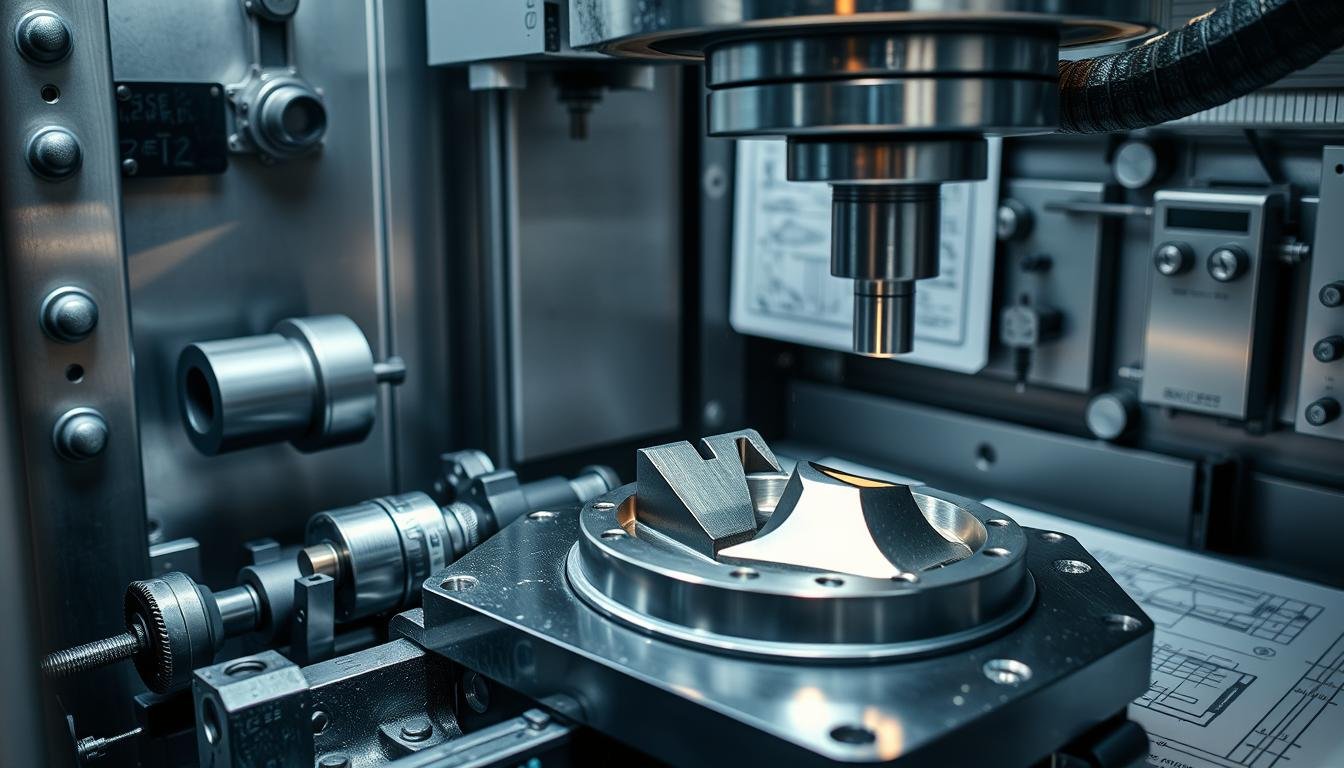Dans le monde d'aujourd'hui, les composants de haute précision sont plus demandés que jamais. La précision Services d'usinage CNC sont à la pointe de l'innovation. Ils créent pièces CNC personnalisées avec une précision incroyable. Imaginez la transformation d'un modèle CAO numérique en une véritable pièce de haute qualité. C'est ce que fabrication de précision à l'ère de l'automatisation. Ces services permettent également de rentabiliser les conceptions complexes.
Avancé Usinage CNC services relient les conceptions numériques aux utilisations du monde réel. Ils fabriquent des pièces très détaillées à partir de fichiers de modèles CAO. Ce processus permet de créer facilement des solutions personnalisées. Les pièces répondent aux normes industrielles strictes, quel que soit le matériau. La technologie CNC fonctionne avec de nombreux matériaux, comme l'aluminium, l'acier et les plastiques. Cela montre sa valeur dans différents secteurs.
Pour les entreprises ayant besoin pièces CNC personnalisées, fabrication de précision est essentiel. Elle fusionne les compétences numériques et les produits physiques. Cela permet de s'assurer que chaque pièce est parfaite. Cette approche est bénéfique pour les petites et moyennes productions. Elle modifie les anciennes méthodes de fabrication et les rend plus efficaces.
Principaux enseignements
- Comprendre le rôle de la précision Services d'usinage CNC dans la production de pièces personnalisées de haute qualité.
- Évaluer la capacité de la technologie CNC à travailler avec une gamme variée de matériaux, des métaux aux plastiques.
- Reconnaître les gains d'efficacité en termes de coûts et de temps Usinage de modèles CAO.
- Identifier les avantages de fabrication de précision pour des productions personnalisées, uniques ou en volume moyen.
- Exploration de l'intégration numérique des services d'usinage CNC dans les systèmes de gestion de l'information fabrication moderne secteurs.
Comprendre la fabrication par usinage CNC
L'histoire de l'usinage CNC est jalonnée d'innovations et de technologies de pointe. Le passage d'outils de base à des systèmes CNC complexes met en évidence des réalisations majeures dans la croissance industrielle. Cette croissance témoigne d'un souci constant de perfection et d'efficacité dans la fabrication.
Brève histoire de l'usinage CNC
L'histoire de la Usinage CNC commence très tôt dans l'histoire de l'humanité. Cependant, les années 1940 ont été marquées par un changement important avec les premières machines automatisées du MIT. Ces machines, qui fonctionnaient avec des cartes perforées, ont amorcé le passage à la technologie CNC moderne. Cette période a marqué le début de l'automatisation dans les domaines suivants la fabrication soustractive.
L'évolution de la technologie CNC
Depuis lors, Technologie CNC a connu d'énormes améliorations. Il s'agit notamment de l'utilisation de l'informatique numérique et du développement de la CAO et de la FAO. Ces changements ont permis à des machines simples d'être hautement perfectionnées et d'accomplir des tâches complexes avec une grande précision.

Composants clés des systèmes CNC
Les systèmes CNC d'aujourd'hui comportent des éléments complexes. Ils comprennent des fonctions multi-axes, des logiciels avancés et différentes options d'outillage. Chaque élément est essentiel pour rendre les machines CNC plus efficaces et plus polyvalentes, en repoussant les limites de la technologie. la fabrication soustractive.
| Composant | Fonction | Impact sur l'industrie manufacturière |
|---|---|---|
| Capacités multi-axes | Permet l'usinage de formes complexes | Améliore la flexibilité et la précision géométriques |
| Logiciel de contrôle avancé | Gérer les opérations de la machine | Augmentation de l'efficacité et de la précision |
| Options d'outillage polyvalentes | Permet divers processus d'usinage | Facilite la production de pièces diverses |
La combinaison de Composants du système CNC montre le chemin parcouru par l'usinage CNC. En se penchant sur son histoire, il montre les progrès technologiques réalisés depuis le début jusqu'à aujourd'hui.
L'importance de l'usinage CNC dans la fabrication moderne
L'usinage CNC a changé fabrication moderne pour l'améliorer. En ajoutant Précision CNCIl permet de fabriquer des pièces avec motifs complexes. Cette technologie joue un rôle important dans la production automatisée plus fiables et plus évolutifs. Elle aide diverses industries à se développer en se concentrant sur l'amélioration de l'efficacité des conceptions complexes.

L'usinage CNC est essentiel pour les production automatisée niveaux. Elle est utilisée dans différents domaines, de l'aérospatiale aux dispositifs médicaux. Cette méthode se distingue par le fait qu'elle permet motifs complexes avec une précision étonnante, encore et encore. Il peut également traiter de nombreux types de matériaux sans perdre le moindre détail ou la moindre précision. Cela montre l'importance de l'usinage CNC dans tous les domaines.
| L'industrie | Avantages de l'usinage CNC |
|---|---|
| Aérospatiale | Fabrication de précision d'aérostructures complexes, reproductibilité accrue |
| Automobile | Production rationalisée de composants durables, possibilités de personnalisation |
| Médical | Production méticuleuse d'implants biocompatibles, de produits de haute qualité et de produits de qualité supérieure. Précision CNC |
| Électronique grand public | Fabrication de petits composants complexes avec une grande précision |
En fin de compte, l'usinage CNC a complètement changé la façon dont les fabricants abordent les projets complexes. Il a également ouvert de nouvelles possibilités dans les domaines suivants fabrication moderne. Grâce aux progrès constants de la technologie CNC, il y a plus d'efficacité et d'options de conception à attendre.
Matériaux et applications de fabrication de l'usinage CNC
Le monde de l'usinage CNC offre un large éventail de possibilités. Matériaux CNC. Ils permettent aux fabricants de créer des composants précis et de haute qualité. Cela permet de garantir Applications CNC peut répondre aux besoins de différentes industries.
Polyvalence des choix de matériaux
Il existe plus de 1600 matériaux qui se prêtent bien à l'usinage CNC. Les industries disposent donc d'un large éventail de possibilités. Les métaux comme l'aluminium, l'acier inoxydable et le titane sont utilisés pour leur résistance. Les plastiques tels que l'ABS, le nylon et le PMMA (acrylique) offrent des avantages en termes de poids et de coût.
Usages industriels spécifiques de l'usinage CNC
De nombreux secteurs dépendent de l'usinage CNC pour leurs pièces vitales. L'aérospatiale a besoin de composants fabriqués avec précision, tandis que l'industrie automobile recherche des pièces très performantes. Dans le domaine médical, des pièces en plastique conçues avec précision sont essentielles. La technologie CNC garantit une précision optimale pour ces pièces.
| L'industrie | Matériaux utilisés | Applications courantes |
|---|---|---|
| Aérospatiale | Titane, aluminium | Composants du moteur, pièces structurelles |
| Automobile | Acier, ABS | Tableau de bord personnalisé, assemblages d'engrenages |
| Médical | PP, Coup d'œil | Prothèses, outils chirurgicaux |
| Électronique | PVC, PMMA | Boîtiers, isolateurs |
Capacités et limites de l'usinage CNC
La technologie CNC a changé la façon dont nous fabriquons des pièces détaillées et complexes. Mais il n'y a pas que des aspects positifs. Pour maintenir la qualité des détails de précision et complexité géométriqueil faut connaître les limites de l'usinage CNC.
Géométries complexes et détails de précision
L'usinage CNC nous permet de fabriquer des pièces aux formes complexes que les anciennes méthodes ne permettaient pas. Cette capacité montre la force des machines CNC modernes. Elle montre également que nous avons besoin d'opérateurs qualifiés et de plans détaillés. Des machines telles que les fraiseuses CNC à 5 axes rendent cela possible. Elles effectuent plusieurs mouvements à la fois, ce qui permet de concevoir des pièces plus originales.
Comprendre les tolérances d'usinage
Pour que les pièces fonctionnent correctement, tolérances d'usinage sont très importantes. Connaître ces tolérances permet de tirer le meilleur parti de l'usinage CNC. Parfois, les outils ou la façon dont nous tenons la pièce peuvent nous limiter. Il est essentiel de planifier en tenant compte de ces limites pour bien utiliser les outils CNC.
Techniques avancées d'usinage CNC
Le monde de l'industrie manufacturière a beaucoup changé grâce à techniques CNC avancées. Les machines multi-axes sont au cœur de ce changement. Ces systèmes sophistiqués améliorent la l'usinage multi-axes processus. Ils permettent un travail plus détaillé et plus précis.
Une avancée majeure dans le domaine de la fabrication est précision du tournage. Cette méthode combine le fraisage et le tournage CNC en une seule étape. Elle permet non seulement de gagner du temps, mais aussi d'améliorer l'efficacité de la fabrication des produits. Elle est donc très utile dans le domaine de la fabrication.
Lorsqu'il s'agit de besoins de fabrication sur mesure, solutions CNC personnalisées sont essentiels. Elles offrent à la fois la flexibilité dans la conception et l'excellence dans la fabrication des produits. Grâce aux technologies les plus récentes, l'usinage CNC sur mesure permet de créer des pièces d'une qualité et d'une précision optimales.
Dans le domaine en pleine expansion de l'usinage CNC, l'utilisation de ces méthodes avancées est essentielle pour rester compétitif. Les fabricants qui utilisent ces technologies peuvent produire davantage et améliorer la qualité de leurs produits. Cela montre que les techniques avancées d'usinage CNC sont essentielles dans le monde industriel avancé d'aujourd'hui.
Production rentable grâce à l'usinage CNC de précision
Pour obtenir usinage CNC rentableLes entreprises utilisent des stratégies pour réduction des coûts de fabrication. Ils se concentrent également sur équilibrer la qualité et efficacité de la production. Cet équilibre est essentiel pour rester compétitif et obtenir des produits de haute qualité sur le marché actuel.
Stratégies de réduction des coûts de fabrication
Il existe des moyens de réduire les coûts sans perdre la qualité du produit. Par exemple, il est important de rendre la conception des composants plus facile à usiner et de choisir les bons matériaux. Ces mesures contribuent à simplifier les conceptions, ce qui réduit les configurations complexes et les longs délais de production, et permet d'économiser de l'argent.
Équilibrer la qualité et l'efficacité
Pour que l'usinage CNC reste efficace et de haute qualité, il est nécessaire de planifier et d'exécuter avec soin. Les usines doivent comprendre les compromis entre vitesse et précision pour obtenir des produits de qualité supérieure. L'utilisation de méthodes CNC avancées et le maintien d'un équipement bien entretenu sont essentiels à cet équilibre.
| Stratégie | Impact sur le coût de fabrication | Impact sur la qualité | Impact sur l'efficacité |
|---|---|---|---|
| Optimisation de la conception pour l'usinabilité | Réduction des déchets de matériaux et du temps d'usinage | Maintien de l'intégrité de la conception | Augmentation du débit |
| Sélection des matériaux | Réduction des coûts des matériaux | Assure la durabilité du produit | Optimise les processus d'usinage |
| Techniques CNC avancées | Minimise le besoin de retravailler manuellement | Améliore la précision dimensionnelle | Amélioration des temps de cycle |
En résumé, l'adoption de usinage CNC rentable Les pratiques aident à réduction des coûts de fabrication. Il aide également à équilibrer la qualité et efficacité de la production. Ces stratégies sont vitales pour les industries qui dépendent de l'usinage CNC pour rester compétitives sur le marché.
Conclusion
Dans cet article, nous avons exploré le vaste monde de l'usinage CNC. Il montre comment il modifie la façon dont nous fabriquons les choses aujourd'hui. Nous avons examiné les événements historiques importants et les différents matériaux qui composent les machines à commande numérique. Succès de l'usinage CNC possible. Cette technologie est essentielle pour pièces fabriquées avec précision très bien et rapidement. Pour l'avenir, nous voyons un secteur qui ne se contente pas de suivre, mais qui va de l'avant.
La technologie CNC a toujours trouvé des moyens de résoudre les problèmes de production difficiles. Avec les nouveaux algorithmes et l'automatisation, son pouvoir s'est accru, aidant de nombreuses industries. De l'aérospatiale aux soins de santé, elle les aide à rester en tête. L'avenir nous réserve plus de Innovations en matière de CNCLes pièces de rechange sont de plus en plus complexes et de plus en plus précises.
Les personnes qui fabriquent et conçoivent des objets se tournent de plus en plus vers l'usinage CNC. La bonne combinaison de nouvelles méthodes sera importante pour continuer à bien travailler. En restant à jour et en faisant preuve de souplesse, le voyage des Succès de l'usinage CNC semble continuer à augmenter. Ainsi, le l'avenir de l'usinage n'est pas seulement brillante. Il devrait permettre d'améliorer les choses et d'aller plus loin que ce que nous réalisons aujourd'hui.
FAQ
Que sont les services de fabrication d'usinage CNC de précision ?
L'usinage CNC de précision implique l'utilisation d'ordinateurs pour contrôler les machines. Ces machines fabriquent des pièces à partir de dessins informatiques. Cette technique est idéale pour les pièces personnalisées et de volume moyen.
Pouvez-vous nous présenter un bref historique de l'usinage CNC ?
Bien sûr. L'usinage CNC a débuté vers 700 avant J.-C. en Italie. Des progrès significatifs ont été réalisés dans les années 1940 au MIT, conduisant aux systèmes avancés d'aujourd'hui.
Quels sont les progrès qui caractérisent l'évolution de la technologie CNC ?
La technologie CNC s'est beaucoup développée. Elle comprend désormais des systèmes robotisés, peut travailler sur plusieurs axes et dispose d'un outillage perfectionné. Les machines sont donc très précises.
Quelle est l'importance de l'usinage CNC dans la fabrication moderne ?
L'usinage CNC est aujourd'hui essentiel pour la fabrication de pièces détaillées et de haute qualité. Il répond aux besoins de précision dans de nombreux domaines grâce à l'automatisation.
Quels matériaux peuvent être utilisés dans la fabrication par usinage CNC et à quelles applications cela sert-il ?
Les machines CNC peuvent traiter plus de 1600 matériaux, y compris les métaux et les plastiques. Elles sont utilisées dans l'aérospatiale, l'automobile, les appareils médicaux, l'électronique, etc.
Quelles sont les capacités et les limites de l'usinage CNC ?
La CNC permet de fabriquer des pièces complexes avec précision grâce à des systèmes multi-axes. Cependant, certaines conceptions peuvent être difficiles à réaliser en raison de l'accès aux outils et des limites de maintien en position de travail.
Quelles sont les techniques avancées d'usinage CNC utilisées aujourd'hui ?
Les techniques avancées comprennent le fraisage 5 axes et le fraisage-tournage avec outillage en direct. Elles permettent d'obtenir des pièces complexes et une conception flexible.
Comment réduire les coûts de production sans compromettre la qualité de l'usinage CNC ?
Pour réduire les coûts tout en maintenant la qualité, il convient d'optimiser les conceptions, d'utiliser des installations plus simples, de choisir les bons matériaux et d'utiliser des techniques avancées.
Quel est le rôle de la CNC en matière d'efficacité et d'équilibre des coûts de production ?
La CNC améliore l'efficacité de la fabrication et contribue à la maîtrise des coûts. Elle utilise des systèmes informatiques pour fabriquer rapidement des pièces précises, réduisant ainsi la main-d'œuvre et les déchets.
Comment l'usinage CNC répond-il aux besoins de production sur mesure et en moyenne série ?
La CNC est flexible pour les pièces sur mesure et les moyennes séries. Son automatisation garantit la qualité et la rentabilité des différentes conceptions.


